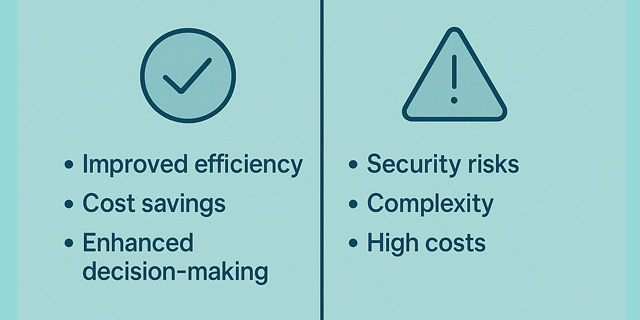AIoT (Artificial Intelligence of Things) is one of the most powerful combinations in modern technology — bringing smart automation into homes, cities, factories, and more.
But while the benefits are impressive, it’s important to also understand the challenges and risks that come with this rapidly evolving tech.
In this article, we’ll explore both the advantages of AIoT and the problems developers and users need to consider.
1. The Key Benefits of AIoT
1.1. Real-Time Decision Making
AIoT systems can analyze data and respond instantly — without waiting for human input.
Example: A smart factory machine detects overheating and stops itself before damage occurs.
1.2. Improved Efficiency
By automating tasks and reducing manual work, AIoT can make operations faster and more accurate.
- Less downtime in factories
- Smarter power usage in homes
- Automated alerts and maintenance
1.3. Cost Savings
Although the setup may be expensive, in the long run AIoT can save money by:
- Reducing labor costs
- Lowering energy bills
- Preventing equipment failure
1.4. Better User Experience
AI-powered IoT devices can personalize settings based on user behavior.
Example: A smart speaker learns your daily routine and adjusts music, lighting, or temperature accordingly.
1.5. Enhanced Safety and Security
In sectors like healthcare, manufacturing, or public infrastructure, AIoT can help detect problems early and prevent accidents.
- Monitor vital signs of patients remotely
- Detect fire or gas leaks automatically
- Secure buildings with face recognition
2. The Challenges of AIoT
2.1. Data Privacy Concerns
AIoT devices collect a lot of personal data — from what time you leave home to your health status.
Without strong data protection, users may face:
- Unauthorized tracking
- Data misuse by companies
- Risk of identity theft
2.2. Cybersecurity Risks
As devices get connected, they also become targets for hackers.
- A smart camera could be hacked to spy on users.
- Industrial systems could be attacked to cause disruptions.
- Strong encryption, regular updates, and secure design are essential.
2.3. High Development Costs
Building a full AIoT system requires:
- Sensors
- Hardware (microcontrollers, edge processors)
- Cloud services
- AI software
These systems can be expensive to develop and deploy, especially for small businesses.
2.4. Compatibility and Integration
Devices from different brands may not work well together — leading to poor user experience or system failures.
Standardization is still lacking in the AIoT ecosystem.
2.5. Energy Consumption
Smart devices require power to collect data, connect to networks, and run AI models. In large-scale use (like smart cities), this can strain energy systems.
Energy-efficient hardware and edge processing can help reduce the load.
3. Balancing Risk and Reward
While the benefits of AIoT are massive, it’s important to approach the technology with thoughtful planning:
- Protect user data and privacy
- Secure every connection point
- Choose hardware and platforms carefully
- Plan for maintenance and updates
4. Conclusion
Like any powerful technology, AIoT brings both opportunities and responsibilities. It can make life easier, safer, and more efficient — but only if it’s designed and used wisely.


